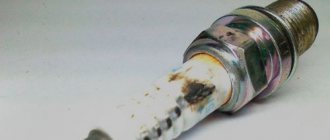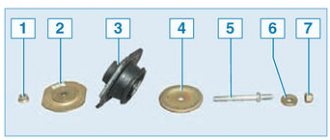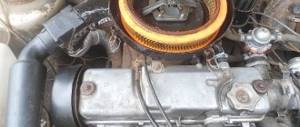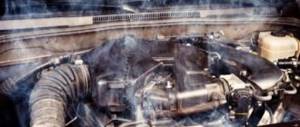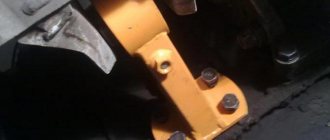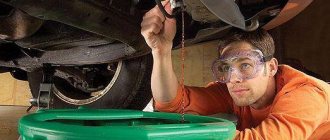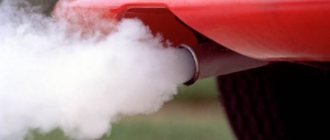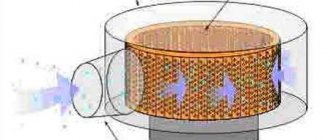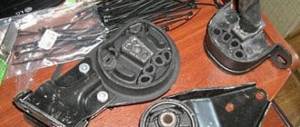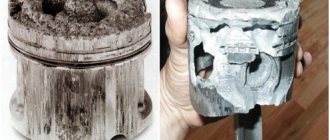Debugg
Once the root causes have been identified, the troubleshooting process can begin directly. We stock up on time and tools. Now that everything is collected, we can begin. It is worth being prepared for the fact that parts will be required.
It is worth noting that for each specific make and model of car, the design features of the repair and location of parts will be different.
Therefore, it is recommended to first review the technological maps and study the design. Moreover, it is best to have a repair manual for the vehicle that will be restored.
Drive belts
Typically, a whistling sound in the engine, especially during a cold start, is associated with belt drives. Thus, a stretched belt slips along the pulley, which creates a characteristic squeak. Often, this effect is characteristic of the timing belt on newer cars. There are two ways to troubleshoot the problem.
The first way is to tighten the belt (only for cars with a belt and a tension pulley). To do this, you will have to dismantle the protective casing that covers the timing belt, and then tighten the drive using a tension roller. Sometimes it happens that the belt is in a very worn condition and requires replacement.
The second way is to replace the belt. Replacing the timing belt is a rather complex and time-consuming task. Therefore, it is recommended to carry out this operation at a professional car service center. Many motorists, unknowingly, when replacing the drive belt, knocked out the valve timing, which subsequently brought with it serious consequences for the power unit, such as major repairs.
For different car manufacturers, the timing of replacing the timing belt will be different, but the average indicator is that the element must be replaced after 40-50 thousand kilometers.
The process of replacing the timing belt is quite simple, but at the same time difficult to complete without knowledge of the design of the vehicle, as well as repair methods. So, let's consider the main provisions for replacing the timing belt:
- To begin with, VTM labels are set. This is necessary in order not to disrupt the valve timing when replacing the belt.
- The camshaft or shafts are fixed on pulleys to prevent rotation. There is a special tool for carrying out this operation, but as practice shows, motorists carry out fixation using improvised methods.
- Next, loosen the belt by unscrewing the tension roller.
- If necessary, on some car models, the crankshaft pulley is removed.
- Remove the belt from the seats.
- Typically, assembly of the unit is carried out in the reverse order. For many American cars, there is a specific sequence for installing the timing belt. Therefore, it is recommended to study the manuals before replacing.
Rollers
Together with the timing belt, the whistling noise may be caused by a worn tension roller. This is because the belt slides over the part, creating a whistling sound. The car rollers are replaced along with the timing belt.
On some cars, the rollers can be replaced without removing the drive belt. It is worth remembering that when changing an element, it is necessary to adjust the tension of the drive belt, because if this is not done, then very soon the whistle will appear again, and the belt will be subject to increased wear.
water pump
Many Lada owners are familiar with the whistling sound that appears after starting the engine when cold and disappears after warming up. This effect was caused by faulty pump parts. In both older and newer car models, the whistling effect can be caused by the water pump.
As with the timing belt, a squealing noise can be caused by a worn water pump belt. On older domestically produced cars, the pump is driven from the crankshaft pulley, while the gas distribution chain operates on a circuit installed directly in the block. For newer cars, the pump is part of the timing belt drive.
Common causes of unpleasant sound
Below we will look in more detail at the common causes of unpleasant sound. We will not consider specific reasons; they are specific to specific car models.
General - depends on external factors and malfunctions.
Resource exhausted
Nothing lasts forever, including a belt reinforced with strong threads. Belt drive transmits enormous energy and handles variable loads. Over time, the belt stretches, its surface wears out, the rubber delaminates, and it is negatively affected by environmental factors. The average resource varies from 40,000 to 60,000 kilometers, but much depends on the conditions in which the car is operated.
Dirty surface
Drive surface cleanliness is one of the most important factors affecting belt service life. If the drive is corroded, dust or dirt gets into it, all this acts as a kind of abrasive that reduces adhesion properties and service life.
The most harmful effects are caused by technical, caustic liquids. Rubber is very sensitive to them. The process of aging and destruction accelerates, in addition to this, the friction force decreases, which is why the belt can slip and make an unpleasant sound.
Mounting location
A minimal deviation from the correct position of the pulleys relative to each other will have a detrimental effect on the belt contact patch. Deviations are: vertical-angular, horizontal-angular, parallel. In such a situation, the belt will slip and make a whistling sound.
Belt tension
If the belt is not tightened tightly enough, it will sag and slip. If it is overtightened, there will be a loss of adhesion, because the torque will prevail over the friction force.
Water on the belt
In most cars, the belt drive is not covered and is not equipped with special protection against water ingress. Therefore, after rain, in high humidity, when the engine warms up, it may whistle. If the sound stops after 5-10 seconds. after turning on the engine, there was definitely moisture on the belt drive, which evaporated after warming up.
Liquid leakage
During operation of the internal combustion engine, various liquids from other engine mechanisms may enter the belt drive, for example, oil from the oil filter or ATF fluid. Usually, in these cases, the alternator belt squeaks rarely. But, with a long service life, it stretches. As a result of various liquids leaking into the belt strips, the belt can run at a slant or move out. This causes a whistle.
This is interesting: How to choose a mass air flow sensor
Bearing condition
Bearings perform the following roles:
- prevention of axial displacements;
- alignment of moving parts;
- reduction of friction.
If the bearing is faulty the following will occur:
- distortions and protrusions of pulleys;
- wedging;
- make an unpleasant “squeal.”
Condition of pulleys and shafts
During operation, pulleys, shafts, and rotors wear out; this occurs less intensely compared to bearings. Traces of mining have the greatest impact on the adhesion properties of the surface.
The wear appears at the points of contact with the bearings, causing play that cannot always be eliminated even by completely replacing the supporting elements.
Huge pressure
If the belt has insufficient tension, the whistle may be caused by the simultaneous switching on of energy consumers such as headlights, heated or ventilated seats, radio, or air conditioning compressor. Together, they place a heavy load on the generator, which is operating at the limit of its capabilities.
In the cold
Belt whistling on a cold engine is caused by excessive belt tension or thickened low-quality lubricant. Both reasons create additional resistance to shaft rotation; as the engine warms up, the problem disappears.
Rain and slush
Moisture on the surfaces of the pulleys does not create any negative consequences for transmission, this is considered normal! However, if there is not enough adhesion properties to transfer mechanical energy, the water that gets into the mechanism acts as a lubricant, causing the drive belt to slip. If you hear a whistling sound, the work surface is most likely worn out!
Conclusion
The causes of whistling in the engine are considered. This effect is usually caused by worn parts. To eliminate the problem, you need to replace one of the elements: belt, tensioner, pump or generator parts. Not all car enthusiasts are able to do the process themselves, so it is recommended to contact a car service center.
An experienced driver can determine the cause of the malfunction and how to eliminate it by the sounds of his car. If the belt whistles when you turn on the air conditioner, then most often the problem is related to the V-belt drive. The article discusses the causes of whistling and methods for eliminating it.
What is the source of the problem?
Most often, a whistle in a belt drive occurs due to friction. This means that the surfaces have lost their original qualities. During operation, the belts, pulleys and bearings of the vehicle are subject to constant load and wear out over time. The following factors influence the quality of components:
- temperature at which the working process takes place;
- ambient air humidity;
- natural wear and tear;
A worn, stretched product is the cause of whistling
- quality of bearing lubrication;
- mechanical damage;
- tension of drive belts.
- check the condition of the belt;
- adjust the belt tension;
- lubricate the tension roller;
- in some models the reason may be the alignment of the pulleys;
- Clean the surface of the strap or replace it if there are traces of oil or antifreeze, which could cause the product to slip.
The reasons why the engine whistles can be different. The problem needs to be solved on a case by case basis.
If a whistle occurs, the following measures must be taken:
The source of the whistle can be not only tension, but also the quality of the part. Sometimes replacing with a new product does not help get rid of the whistling sounds. Therefore, you need to buy only original consumables from well-known manufacturers.
Why does the driver hear a whistle?
When the power unit operates in a car, the belt, along with other drive belts, experiences maximum loads.
Most of the drive belts installed in the machine have a wedge shape, which provides a greater frictional force in the place where the part contacts the pulleys. Such elements even have appropriate names - V-belts.
These same products, but having several paths at once, called streams, are called polywedges.
Generator belts can be with or without teeth. It is generally accepted that products with teeth have a longer service life, since they wear out and slip less often.
So why is there a whistle? In 95% of situations, the manifestation of an unpleasant whistling sound occurs due to the friction of the belt on the pulley if slippage occurs. It turns out that when the belt is unable to turn the pulley, then it slips. This action is accompanied by a sound resembling a whistle.
The motorist should not look for the cause of the sound, but for faults that cause the belt to slip.
- Weak and, conversely, very tight tension of the generator belt. Over time, the belt may stretch. The main reason for this is wear and tear of the lower part of the part. The car owner will only need to tighten the connection point. However, it is important to remember not to tighten it too much. In the longest section, the blade should have a stroke in the range of 8 - 10 millimeters. A belt that is too tight can also cause a squealing noise. It is no secret that extremely tight tension does not allow the pulleys to rotate normally. This situation often occurs in winter. The squeak disappears from the moment the engine reaches operating temperature and the belt takes its previous shape.
- Poor quality or temporary wear of the belt. Often, the material used in the production of the belt itself is not the same material applied to the outside of the product from Chinese manufacturers. When the top layer wears, the belt makes a squeaking sound. If the wear is too great, then even the next tension will not help eliminate the problem with the belt whistling. When cracks appear on the product or traces of major destruction can be visually detected, the problem can be corrected by replacement. There is no point in delaying this issue, since such a belt can break at any time.
- Contact with the pulley or belt of technical fluid used in the operation of the machine, for example, oil, washer fluid and even plain water. Problems with whistling appear most often due to contact with engine oil. The belt loses its previous grip and slips with the appearance of a characteristic sound.
- Malfunction of the tension roller or generator bearing. A technical problem with the bearing can cause an unpleasant sound emitted by the hanging belt. The owner of the car will only need to replace the bearing. This structural unit also has special tension rollers. This part is a type of bearing that can begin to seize over time. Because of this problem, the movement of the belt drive is disrupted, the belt rubs heavily against the pulley. In this situation, the belt will show signs of severe wear. The car owner must inspect the mechanism, remove the belt and check the play of the rollers.
- Axle mismatch between pulleys. The appearance of a nasty whistle may be due to misalignment of the line between the two pulleys. The pulleys must be positioned strictly on the same axis, and even a slight slope can cause a whistle.
This is interesting: How to independently measure the pressure in a car’s fuel rail
There are several pulleys in a car. The first is located on the crankshaft, and the second on the generator. With constant use of the car, the pulleys wear out. A small pulley is installed on the generator; on the crankshaft, on the contrary, the largest one is installed. Most of the load will go on the small pulley. Some automakers make a small alternator pulley from not the most durable materials. Therefore, wear of the teeth on this part is a matter of time. In addition, situations often occur when damage occurs on the track itself, for example, after an impact.
In any case, the car owner will need diagnostics and replacement of damaged parts.
You will also be interested in:
- How to check the generator voltage regulator
- Signs of a faulty generator diode bridge
- How to check the generator without installing it on the car
Diagnostics and repair
When turning on a cold engine, a whistling noise may occur, which may be caused by the belt slipping on the pulleys. Until the car is warmed up in the cold season, the lubricant in the bearing is sometimes of such a consistency that the belt cannot turn the pulley and slips. The reason for this may be poor quality lubrication, poorly tensioned strap, or wear. The situation can be corrected by changing the oil, adjusting the belt tension, and replacing it in case of wear.
But first you need to check if the pulley is spinning. There are times when a unit jams, then first of all it needs to be repaired. The cause of the whistling may be wear on the surface of the alternator pulley; in some cars it is in the open state. In models where the alternator pulley is located below the crankshaft pulley, the pulley may jam, especially on SUVs. If a toothed belt is installed, then the reason is the bearing.
How to eliminate a whistling alternator belt
You can get rid of the generator belt whistling by eliminating the reasons that cause it to slip on the pulleys.
If there are signs of belt slipping, accompanied by an unpleasant whistle, we suggest eliminating it in the following order:
- Stop the engine, open and secure the hood to prevent it from closing spontaneously;
- Carefully inspect the alternator belt without removing it from the car. There should be no tears, protruding threads or other visible damage on its surface. If they are detected, the belt must be replaced with a new one.
- Both the inner and outer sides of the belt must be dry and clean, without traces of dirt, oil and other vehicle technical fluids. The same applies to pulleys.
- Check the degree of belt tension - in most cases, the cause of a whistle from under the hood is precisely the weak tension of the generator belt. We wrote about how to properly check the tension level of the alternator belt here.
For information on the optimal degree of tension of your car's alternator belt, refer to its operating instructions.
- If necessary, adjust the belt tension. A good video instruction for adjusting the alternator belt is at the bottom of this page.
- If all of the above did not help and the alternator belt continues to squeak obnoxiously, then with the engine running and good lighting, carefully inspect the line of pulleys for alignment.
An indirect sign of pulley misalignment is the poly V-belt jumping from track to track and sliding off the pulley.
- Pay attention to the linearity of rotation of the pulleys - if any pulley rotates in a figure eight, it will tear and throw off the belt. Most often, pulleys with a rubber damper behave this way, which over time loses elasticity and ceases to perform its functions.
And so, if the generator belt has not stopped whistling, but it is intact, clean, well tensioned, and the pulleys rotate smoothly and smoothly, then you can try to correct the situation using another method:
- Remove the alternator belt and carefully inspect it again for damage and dirt. If the belt is intact, then you need to clean its surface from the inside and outside (you can use gasoline or kerosene); if damage is found, buy a new belt.
- With the generator belt removed, thoroughly clean the pulleys from dirt and dust. This is best done with a wire brush. You can also use gasoline or kerosene.
- Place a clean belt on the clean pulleys and adjust its tension. After this, the whistling of the alternator belt should disappear.
If all of the above did not help and the belt whistle has not gone away, then the problem lies either in the quality of the belt itself or in the equipment that is driven by it: tension rollers, generator, power steering pump, air conditioning compressor, etc. Perhaps the grease in the bearings has simply thickened or they have failed, or perhaps the reason is much more serious, so in this case it would be better to seek help from a car service specialist.
You can try to temporarily eliminate the whistling noise using special auto chemicals, so-called conditioner-tensioners for drive belts. This, of course, will not solve the problem, but the whistling will disappear for a while.
This is interesting: How to independently restore studs on studded winter tires
Replace
You should only take a replacement belt that is suitable for the attachment of a specific vehicle model. Reservations from store managers such as “almost the same” cannot be accepted: the product either will not stand up or will not stretch properly.
It will not be possible to develop a general replacement method - each car has its own nuances of setting up a poly-V-belt transmission. Therefore, the best recommendation is to read the service manual for your specific machine. There is nothing complicated in the process - all you need are tools and free time.
Correct belt tension
If the squeak is caused by weak belt tension, you can adjust it yourself. Formally, the degree of tension depends on the specific car model (some manufacturers even indicate exact force values), but in practice it is adjusted by touch, measuring the belt deflection manually. To do this, press at the point of the belt furthest from the pulleys and rollers with a finger: with the correct tension, the belt should bend by about 10–15 mm.
After adjusting the belt tension, you need to start the engine and listen: the whistle should disappear, and the electrical equipment should work without fluctuations or failures. Otherwise, the adjustment must be repeated.
There are several ways to tension the belt, depending on the design of the adjustment mechanism.
Adjusting arc-shaped bar
To check the tension, you need to press on the belt: it should bend by about 10–15 mm.
In older cars, the belt is tensioned using a so-called bar, which attaches the generator to the engine and is secured with a bolt and nut. The procedure is very simple: having loosened the clamping nut, you need to knock the bar with a hammer or pry bar, changing the position of the generator relative to the engine, and then tighten the nut back.
Adjustment bolt
Another old mechanism still found on cars is tension using a special bolt. Before adjustment, it is necessary to loosen the generator at the lower and upper points, then change its position using the adjusting bolt, while simultaneously controlling the belt tension. Having reached the desired force, you need to tighten the generator mounting nuts back.
Belt self-tensioning
Most modern cars with a poly-V belt do not have manual adjustment: this function is performed by a special automatic tensioner. According to the operating principle, they are divided into three groups: damper, compression spring based and torsion spring based. The latter are most widespread due to their simplicity, reliability of design and compact size. Due to the force of the spring, a constant tension of the drive belt is maintained, and if the force weakens, you simply need to replace the tensioner with a new one.
How often should the drive belt itself be changed? Each automaker has its own recommendations; usually the replacement interval is 45–60 thousand kilometers. However, checking the condition of belts and pulleys (at least visually) should be carried out regularly: for example, at every engine oil change. This will prevent unexpected belt breakage or sudden squeaking.
Given the low cost and light weight, it is wise to always carry a spare drive belt with you, especially on a long trip. Its presence in the trunk will help out in case of a sudden break or detection of critical wear - you won’t have to resort to old-fashioned field repair methods (winding nylon tights around the pulleys instead of a belt) in order to make it to service. And to extend the service life of the belt, you should keep it clean and use a special lubricant, which increases its flexibility and durability.
Replacing and tensioning an alternator belt doesn't require any fancy equipment, but working in a cramped engine compartment can be time-consuming and labor-intensive. Therefore, to change and adjust drive belts, it is better to contact a trusted car service center, where everything will be done quickly and professionally.
Video “Whistling in the engine during cold start”
This video explains the cause of the whistling noise that occurs when starting a cold engine and how to eliminate it.
Almost everyone has heard a nasty squeak in the morning when starting the engine. The time for symphonies usually begins in the fall and continues until late spring. Meanwhile, you don’t have to look for the source of the frightening squeal for long - it is under the hood in the area where the attachments are located. It is often driven by a belt drive, the elements of which can produce extraneous sounds. The defect is not critical, but it is unacceptable to ignore it.
Why does the belt of additional units whistle when starting the engine when cold: probable reasons
How to make sure
It’s not difficult to guess what to do when the alternator belt squeaks or what to do when it whistles - you need to check the tension. Often the belt structure is weakened due to unqualified assistance or stretching during long-term use. This is the first and simple rule when such a malfunction is detected. By the way, it is only available in the case of recent installation of a new product.
However, not all machines have units connected through a generator. On many cars with a timing chain drive, there may be two belts: one connects the current-generating unit and the cooling system pump to the engine. The second is a power steering pump and an air conditioning compressor with a motor.
The test method involves applying additional load to the belts by using the maximum power of the attachment. The alternator belt may squeal at idle if all electrical appliances are activated at the same time:
- Heated seats.
- Car radio.
- Heated side mirrors and rear window.
- High beam headlights.
- Cabin heater.
Other possible causes of whistling under the hood: power steering, air conditioning, water pump
Similar to the main reasons for whistling generator belts, similar noises can occur in other units that are driven by a belt drive. The air conditioning compressor, or rather the clutch drive belt, may whistle. This can be easily checked by turning the air conditioning system on and off. In rare cases, the generator belt may whistle after turning on the climate control, which occurs as a result of a significant increase in the load on the generator.
You should also not exclude:
- possible slippage of the compressor drive clutch, which becomes more difficult to spin due to an insufficient amount of refrigerant (frion) in the system. The fact is that freon is a lubricant for the compressor;
- It is additionally necessary to check the performance and quality of lubrication of the compressor bearings and pulley, which will depend on the features of a particular design. Similar recommendations can also be applied to the power steering pump and its drive, as well as to the liquid pump of the engine cooling system;
Briefly about the causes and ways to eliminate them
If the belt begins to whistle when starting the car engine when cold, this is evidence that it is slipping. Inspection required. It is worth checking both the cleanliness and absence of cracks, and the tension level. A dirty, oily strap with a cracked working surface must be replaced. Dirt getting on the strap causes rapid wear not only of it, but also of the pulleys.
A clean product with a margin of service life is still suitable - just tighten it up if the system allows it. If this is not the case, then only installing a new one will help. The whistle appeared after a recent replacement - the belt was not tightened. Tightening does not help - either the pulleys are worn out, or the rubber product is not original. In special cases, a skewed tensioner is to blame for the squeak.
